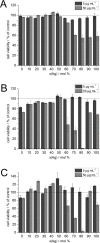Synthesis, characterization and in vitro effects of 7 nm alloyed silver-gold nanoparticles
- PMID: 26171298
- PMCID: PMC4464341
- DOI: 10.3762/bjnano.6.124
Synthesis, characterization and in vitro effects of 7 nm alloyed silver-gold nanoparticles
Abstract
Alloyed silver-gold nanoparticles were prepared in nine different metal compositions with silver/gold molar ratios of ranging from 90:10 to 10:90. The one-pot synthesis in aqueous medium can easily be modified to gain control over the final particle diameter and the stabilizing agents. The purification of the particles to remove synthesis by-products (which is an important factor for subsequent in vitro experiments) was carried out by multiple ultracentrifugation steps. Characterization by transmission electron microscopy (TEM), differential centrifugal sedimentation (DCS), dynamic light scattering (DLS), UV-vis spectroscopy and atomic absorption spectroscopy (AAS) showed spherical, monodisperse, colloidally stable silver-gold nanoparticles of ≈7 nm diameter with measured molar metal compositions very close to the theoretical values. The examination of the nanoparticle cytotoxicity towards HeLa cells and human mesenchymal stem cells (hMSCs) showed that the toxicity is not proportional to the silver content. Nanoparticles with a silver/gold molar composition of 80:20 showed the highest toxicity.
Keywords: cytotoxicity; gold; nanoalloys; nanoparticles; silver.
Figures






References
-
- Schmid G. Nanoparticles. From Theory to Application. Weinheim, Germany: Wiley-VCH; 2004.
LinkOut - more resources
Full Text Sources
Other Literature Sources
